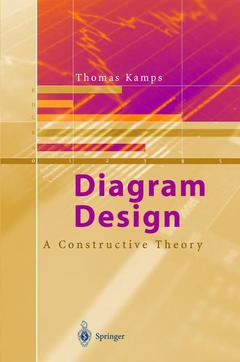Description
Diagram Design, Softcover reprint of the original 1st ed. 1999
A Constructive Theory
Author: Kamps Thomas
Language: French
Subject for Diagram Design:
Keywords
Publication date: 10-2011
191 p. · 15.5x23.5 cm · Paperback
191 p. · 15.5x23.5 cm · Paperback
Description
/li>Contents
/li>Comment
/li>
A systematic analysis of diagrams as visual representations of factual knowledge. The analysis shows that the design process may be divided into three phases: data classification, graphical decision, and layout. Performed in this order, the three phases more or less reflect the design process of a human expert. They also serve as a basis for a constructive theory for diagram design, which is the main focus of this book. XXXXXXX Neuer Text This book is a thorough presentation on the foundations of visualizing information, providing a systematic analysis of diagrams as visual representations of factual knowledge. The analysis shows that the design process may be divided into three phases: a data classification phase, a graphical decision phase, and a layout phase. Performed in this order, the three phases reflect the design process of a human expert and serve as a basis for a constructive theory for diagram design.
1 Introduction.- 1.1 Historical Review of Publishing.- 1.2 The Publication Process.- 1.3 The Publication Environment.- 1.4 The Problem.- 1.5 A Solution.- 1.6 Overview.- 2 Related Work in Automatic Diagram Design.- 2.1 Constructive Decision-Based Design Approaches.- 2.2 Summary and Discussion.- 3 Data Structure.- 4 Introduction To the Approach.- 4.1 How to Establish Expressiveness.- 4.2 How to Establish Effectiveness.- 4.3 Conflicts in Graphical Resource Allocation.- 4.4 Summary and Discussion.- 5 Relation Classification.- 5.1 Binary Relation Classification.- 5.2 Classification of n-ary Relations.- 5.3 Classification of Object Networks.- 5.4 Summary of Relation Classification.- 6 Graphical Mapping.- 6.1 Graphical Binary Relations.- 6.2 Graphical Binding.- 6.3 Visualisation Strategies for n-ary Relations.- 6.4 Summary of Graphical Mapping.- 7 Layout and Implementation.- 7.1 Layout.- 7.2 Implementation.- 7.3 Summary of Layout and Implementation.- 8 Conclusions.- 8.1 Summary and Results.- 8.2 Comparison with the State of the Art.- 8.3 More Application Areas for EAVE Components.- 8.4 Interesting Unsolved Problems.- A Definition of Relational Properties.- B Relation Type Concepts.- C Quantitative-Perceptual Limitation Constants.- D Coloured Illustrations.
A thorough presentation of the foundations of visualizing information The author demonstrates the efficiency of graphical communication Information visualization is a "hot topic" not only in scientific contexts
© 2024 LAVOISIER S.A.S.

